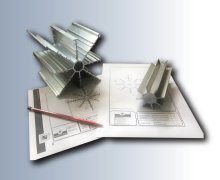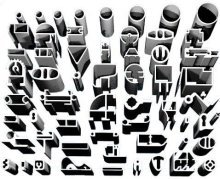



Platten
Blech
Rundstangen
Rohre/ Extrusion/ Profil
7050
AMS 4201 / AlZn6CuMgZr / 7050 / T7651
| Chemical Properties | % Value |
| Silicon (Si) | 0,00 - 0,12 |
| Tin (Sn) | 0,00 - 0,00 |
| Chromium (Cr) | 0,00 - 0,04 |
| Manganese (Mn) | 0,00 - 0,10 |
| Magnesium (Mg) | 1,90 - 2,60 |
| Copper (Cu) | 2,00 - 2,60 |
| Lead (Pb) | 0,00 - 0,00 |
| Titanium (Ti) | 0,08 - 0,21 |
| Iron (Fe) | 0,00 - 0,15 |
| Zinc (Zn) | 5,70 - 6,70 |
| Nickel (Ni) | 0,00 - 0,00 |
| Aluminium (Al) | Balance |
| Titanium + Zirconium (Ti+Zr) | 0,08 - 0,15 |
| Physical Properties | Value |
| Density | 2,83 g/cm³ |
| Melting Point | 488 °C |
| Thermal Expansion | 23.5 µm/m.°C |
| Modulus of Elasticity | 71.7 GPa |
| Thermal Conductivity | 153 W/m.K |
| Electrical Resistivity | 35 % IACS |
| Mechanical Properties | Value |
| Proof Strength | 500 MPa |
| Yield Strength | 552 MPa |
| Shear Strength | 324 MPa |
| Elongation A50 mm | 10 % |
| Hardness | 147 HB |
The 7050 T7651 aluminum alloy is known for its high strength, durability, and excellent corrosion resistance. As part of the aluminum-zinc alloy family, it is primarily used in aerospace, space, and military applications, particularly in high-performance structural components. The T7651 temper, achieved through specific heat treatments, provides the alloy with high durability and stress resistance while maintaining machinability. These characteristics make the 7050 T7651 alloy ideal for heavy-load-bearing applications requiring high durability and strength.
The 7050 T7651 aluminum alloy has limited suitability for anodizing. Its high zinc content prevents the formation of an effective oxide layer during anodizing, making anodizing an unsuitable method for protection. Therefore, other coating methods are generally used for protection. In terms of weldability, the 7050 T7651 alloy requires careful handling during welding. The high zinc content increases the risk of cracking during welding, so proper welding techniques and appropriate filler materials are necessary to minimize this risk.
In terms of bending and forming, the 7050 T7651 aluminum alloy presents challenges due to its high strength. However, with the correct processing techniques, successful bending and forming can be achieved. Additionally, the 7050 T7651 alloy is suitable for use in high-vibration environments. Its high elastic modulus and durability make it ideal for vibration-resistant components such as engine parts, chassis, and other components exposed to vibrations.
Regarding corrosion resistance, the 7050 T7651 aluminum alloy shows exceptional resistance, particularly against seawater and humid conditions. This makes it an ideal material for maritime applications and equipment exposed to moisture. The advantages of the 7050 T7651 alloy include high strength, durability, and lightweight properties, while its disadvantages include limited corrosion resistance and challenges in welding.
Choosing Factors for 7050 T7651
- Strength: Very good
- Machining: Okay
- Weldability: Poor
- Formability: Average
- Corrosion Resistance: Excellent
- Heat Treating: Yes
Some Well-Known Applications for 7050 T7651
It is also used in commercial and military aircraft,
Aircraft wings and fuselages,
Aircraft and ship bulkheads.
- Rod / Round Bar / Flat Bar
- Plate
- Sheet
- Tube/Profile
| Mechanical Properties | |||
| Thickness (mm) | Proof Strength (Min.) | Yield Strength (Min.) | Elongation A50 mm % |
| Over 6.3 up to & incl. 51 | 441 MPa | 510 MPa | 9 |
| Over 51 up to & incl. 76 | 434 MPa | 503 MPa | 8 |
| Over 76 up to & incl. 102 | 427 MPa | 496 MPa | 6 |
| Over 102 up to & incl. 127 | 421 MPa | 490 MPa | 5 |
| Over 127 up to & incl. 152 | 414 MPa | 483 MPa | 4 |
| Over 152 up to & incl. 178 | 407 MPa | 476 MPa | 4 |
| Over 178 up to & incl. 203 | 400 MPa | 469 MPa | 4 |

 Gewichts-Kalkulator
Gewichts-Kalkulator

